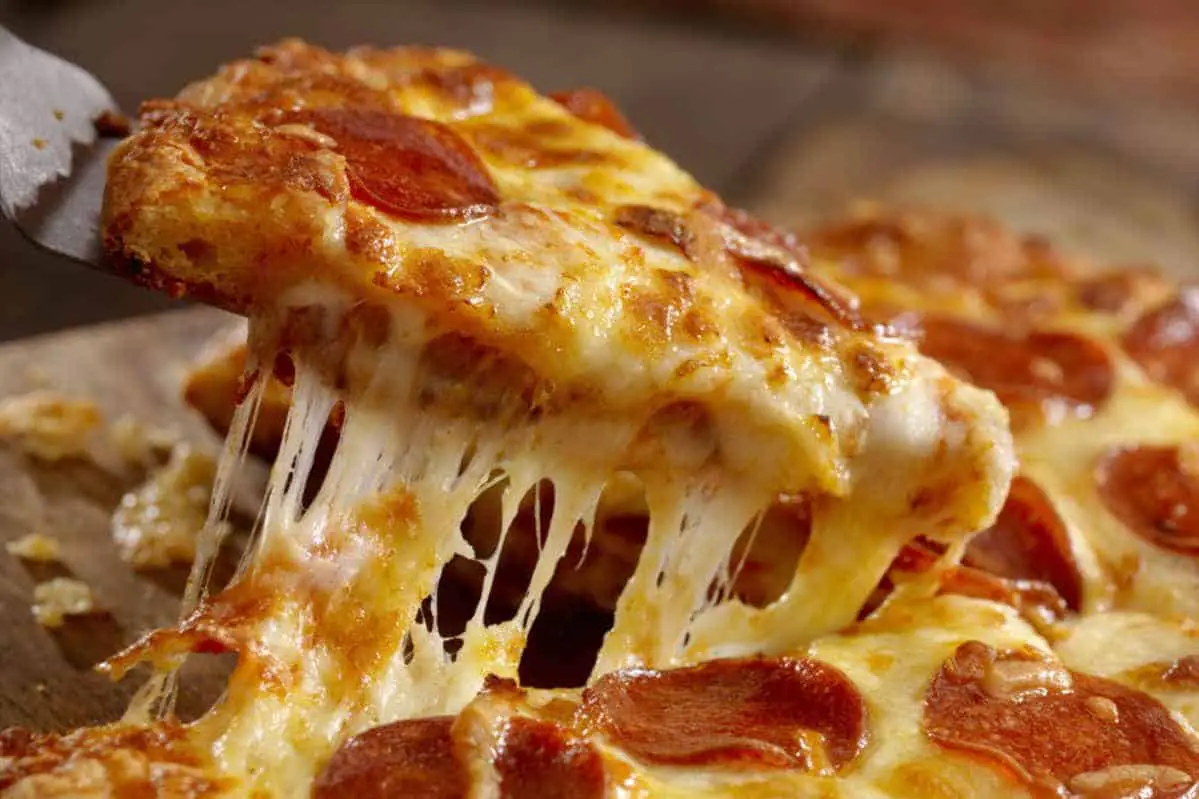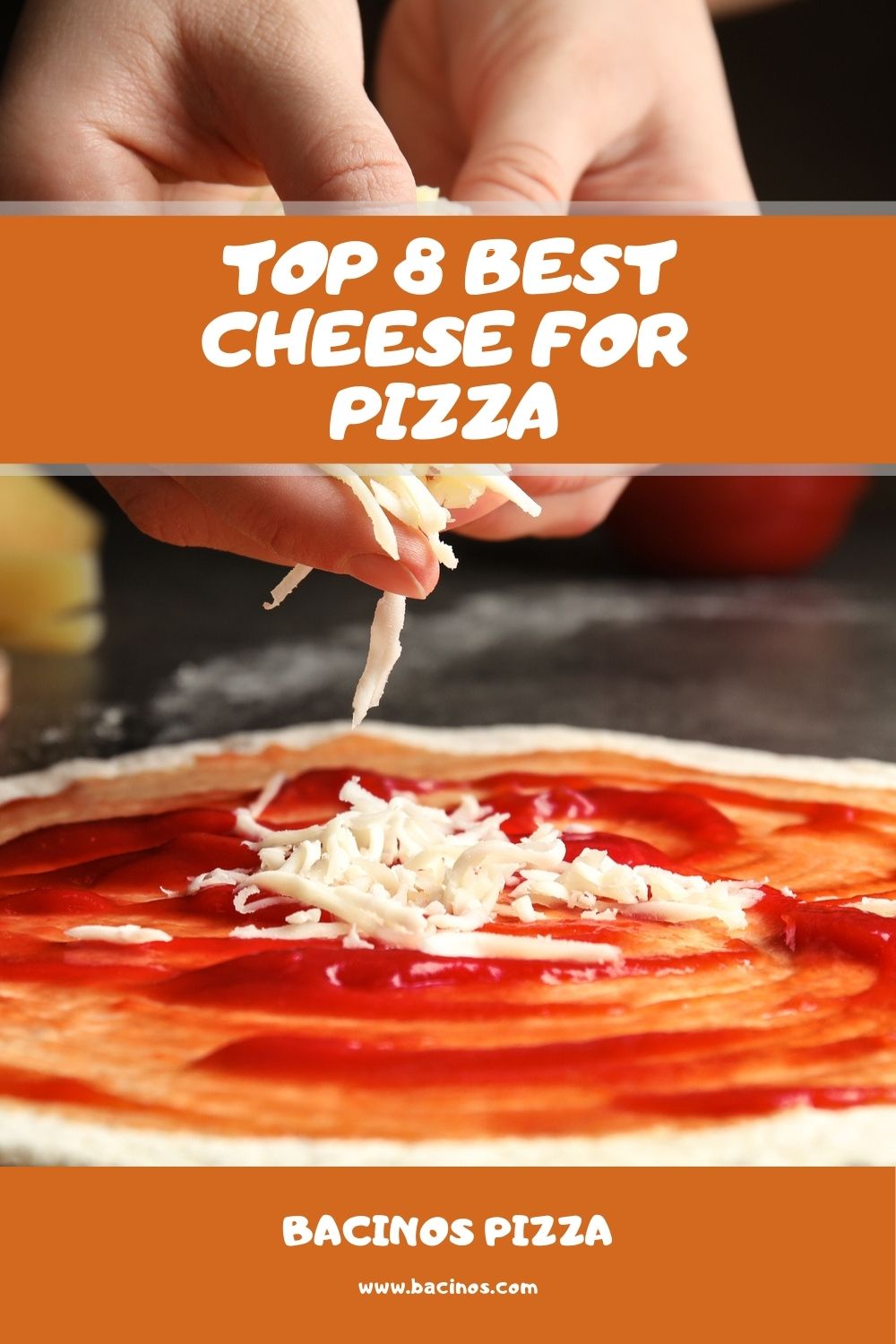Is there anything better than a delicious pizza? What about a freshly cooked pie with the perfect cheesy topping?

But when it comes to the cheese on our favorite pizza, there’s a lot of debate. So what is the best cheese for pizza? Never fear – we’re here to help guide you through the options!
So if you’re ready, sit back and prepare to learn more.
What Makes A Good Cheese For Pizza?
To start, let’s think about what makes cheese work well as a pizza topping.
First and foremost, of course, this is all about the flavor. You might want something with enough presence not to be overpowered by the tangy tomato sauce. And you’ll also want a taste that will work well with other toppings on your pie.
Another essential factor to bear in mind is how well the cheese melts. When your pizza comes out of the oven, you want your cheese fresh and soft, contrasting with the crispy base. And that will also allow the flavor to melt into your other toppings for a delicious combination.
Depending on how you’re using your cheese, you may also want it to go brown. That can give your pizza an attractive golden glow.
So with that in mind, what cheeses make the pizza grade?
The Best Cheese For Pizza
1. Mozzarella
One of the most commonly used cheeses for pizza, Mozzarella, can be used as a topping in different forms. Thick discs of this fresh cheese will impart a delicious creaminess to your pie. It works well with the tomato because it’s so different, complementing the tart sweetness of the sauce.
Mozzarella and tomato are so well-loved combinations that it’s integrated into many non-pizza forms. Italians will often snack on a tomato and mozzarella salad. Add some basil and olive oil, and you have the Caprese salad, another famous export from Italian cuisine.
Fresh Mozzarella works beautifully as the main topping for your pizza. But we’ve heard some online reviewers about its moisture leaving the crust soggy. Although, on our side, we’ve never experienced that problem.
But if you’re concerned, you can dab your Mozzarella slices with kitchen paper before placing them on your pizza. Space them across the top evenly, and you won’t have to worry about excess moisture causing problems.
And if you want your cheese to provide a background to other flavors, grated Mozzarella is a good alternative. For this, you’ll want a low-moisture form of the cheese. And if it’s still not firm enough to grate, you can pop it into the freezer before for a few minutes.
Whether grated or freshly sliced, Mozzarella will melt beautifully on your pizza. And it will give your topping a chewy elasticity, which works brilliantly against a crispy crust.
For many people, searching for the perfect pizza cheese will stop at Mozzarella. But if you prefer something with a robust flavor, we still have plenty of other options for you to try.
2. Cheddar
Cheddar is America’s favorite snacking cheese, so it makes sense that it will also go down well on pizza. And if you choose a mature, extra mature, or vintage option, it will add plenty of punchy flavors.
If you’re using cheddar cheese, grate it, don’t slice it. You can be as generous with your topping as you like. But remember: if you use loads of cheese, you will get puddles of oil when you bake your pizza. They’ll evaporate if you cook your pizza for longer. But watch out so that the edges don’t burn.
A strong cheddar is ideal for pizzas where you want the cheese flavor to take center stage. It also works well with other cheeses. And despite being powerful, it will still complement pretty much any meat, fish, or vegetable.
3. Goat Cheese
Goat cheese is another excellent choice for those who prefer a sharp flavor. It’s salty, tangy, and delicious. And it works brilliantly alongside the sweetness of roast peppers and onions on a vegetarian pizza.
Goat cheese works better on your pizza if sliced in discs. Also, cut it only once it’s ready to go into the oven. It melts beautifully, and it will also brown in the heat. It will make your pizza look scrumptious—you’ll have trouble keeping your hands off it until it cools down!
But be warned—we have seen some places recommend treating goat’s cheese similar to cream cheeses like mascarpone. It is madness! Goat’s cheese may have a softer texture than cheddar, but that’s where the similarity to cream cheeses begins and ends.
Goat cheese has a strong flavor, which needs careful treatment and usage. Don’t overdo it—a few slices will be enough to add piquancy to your pizza. And take care when choosing what other toppings you pair it with too. It’s best to use it in place of meat or seafood rather than alongside them.
4. Pecorino Romano
Authentic Pecorino Romano originated in Tuscany from sheep’s milk. It’s aged for at least eight months to develop its distinctive nutty flavor.
When made in the USA, the cheese has different characteristics and is usually called Romano. Most of the time, it forms from cow’s milk rather than sheep’s milk. And it’s left for a far shorter time to mature. The result is a cheese with a milder flavor.
If you can get your hands on authentic Pecorino—savor it! And don’t put it into the oven when you bake your pizza. Instead, grate it in large shards over the surface when it comes out. Another great option is to toss it with arugula before spreading it on top of your pie.
5. Blue Cheese
Blue cheese isn’t to everyone’s taste. But used in moderation, it can provide a delicious counterpoint to vegetables and nutty toppings. Think caramelized onions, mushrooms, spinach, walnuts, and red onion.
And it can also work well with sweet flavors. For example, pear, prosciutto, and crumbled blue cheese make a delicious pizza topping.
Keep your pizza authentically Italian by choosing gorgonzola as your blue cheese. Its flavor can vary, depending on how long it aged. Young gorgonzola is soft and creamy, while more mature versions can be strong, bordering on pungent.
It is a cheese where a little goes a long way. But don’t be afraid of it! Pair it with the right toppings, and it will deliver a genuinely superior pizza.
6. Toma
Toma cheese is a crucial ingredient in some styles of authentic Sicilian pizza. So what is it?
Toma translates as “farmer’s”, but when in the US, you’ll find it under the label “farmer’s cheese”. Although, it may take some time to locate this kind of cheese. Artisan grocery stores importing their wares direct from Europe are your best bet.
But is it worth the effort?
We think so—especially if you’re making a Sicilian pizza. It’s a semi-hard cow’s milk cheese made in Sicily and the northern regions of Italy. It’s pale yellow, with a creamy texture and soft, buttery flavor.
It will go well with most toppings. And if you prefer to keep your pizza simple, it has enough flavor to stand alone with tomato sauce. It melts very nicely too.
7. Parmigiano Reggiano
Another Italian favorite on pizzas is Parmigiano Reggiano. And like Pecorino, this is a cheese that’s best put on your pizza after it’s come out of the oven.
But before saying more on this, here’s a word on parmesan. Parmesan and Parmigiano Reggiano are not the same thing. The latter has a protected designation of origin. In other words, for a product to be called Parmigiano Reggiano, it must be made in Italy. And it must be crafted using a specific process.
Cheeses labeled “parmesan”, on the other hand, have no such requirements. They aim to resemble the original Parmigiano. But all too often, they fall flat.
In particular, we’d recommend steering clear of powdered parmesan you’ll find in large jars. Unfortunately, it tastes nothing at all like the real thing.
Now we’ve cleared that up, how should you use Parmigiano Reggiano on your pizza?
Our favorite way is to grate large shards atop your pizza after it bakes. That will give you a brittle texture with a sharp, salty hint of flavor.
Some people prefer to grate it more finely and mix it with grated cheddar, applying it to the pizza before baking. Though, it feels a shame to us to dilute the flavor of what’s often known as the king of cheese.
8. Provolone
Last but not least is another Italian favorite, provolone. It is another cheese that varies in taste and texture according to how long it’s left to mature. Young provolone is mild, sweet, and creamy. More mature versions will be drier with a robust, sharper flavor.
Both types of provolone melt well. The young provolone has a slightly stronger taste than mozzarella, while the aged provolone has a much more robust flavor. They work particularly well mixed with mozzarella as the cheese layer in your pizza.
Deli provolone is another good option for pizza. The flavor here is much milder, but it also melts beautifully.
What Toppings Goes With Each Type of Cheese?

Now that you know the best cheese for your pizza, here are some toppings you can pair with. It will help you to discover different flavor styles but feel free to go outside the box. You can add more or keep it classic for a chill day.
Another thing, take note of the cheeses’ taste profile, as we mentioned earlier. It will help you decide what ingredients would go well and what not.
| Type of Cheese | Ideal Combination |
| Mozzarella | Fresh seasonal produce like roasted peppers, plump tomatoes, and grilled zucchini are ideal. |
| Cheddar Cheese | You can stick with classic meats like ham, pepperoni, or bacon. |
| Goat Cheese | Figs and arugula are excellent toppings if you want to mimic the flavors of the salad. Another alternative is caramelized onion for a toned-down sweetness. |
| Pecorino Romano | The taste develops if you pair it with flavorful toppings like prosciutto, sausage, or red and green pepper. |
| Blue Cheese | You can pair it with bechamel sauce and bacon for a gourmet-style pizza. |
| Toma | For a savory taste, you can pair it with pepperoni. But for a healthier option, you can use BBQ chicken and add some Gouda cheese. |
| Parmigiano Reggiano | Try it with dollops of mascarpone, fresh basil leaves, and heirloom tomatoes. |
| Provolone | Combine it with fresh minced garlic, sliced basil, and plump tomatoes for a robust flavor. |
Aside from the savory and fresh fixings, you can combine any of the three types. An example is the mixture of Mozzarella, Parmigiano Reggiano, and Goat cheese. And to make it a Quattro Formaggi pizza, you can add Gorgonzola.
Like blue cheese, Gorgonzola has a creamy texture, but it has a slightly sweet flavor. The depth can range from mild to sharp based on the aging period. In all, it can impart a rustic taste that marries well with other commonly used cheese.
What’s Your Favorite Cheese For Pizza?
We hope you’ve enjoyed our tour of some of the best cheeses out there for pizza! Whether you want to stick to super-authentic options like Toma or mix it up with good old cheddar, they all have something to offer.
If you’re unsure which will suit you best, why not experiment? You’re sure to find something that suits you and your pizza. And you’ll have lots of fun along the way!


Barbara is an enthusiastic food-exploring person that goes through different culinary experiences. She got inspired by creating a pizza blog post after she tasted one of the best-selling pizzas in Toledo.